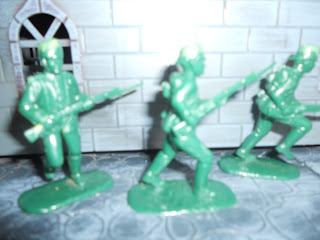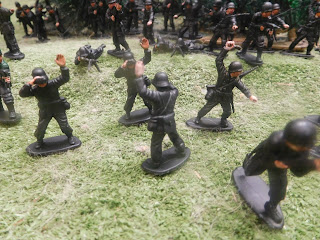Medieval Fantasy Melee Rubric
So after requests here is my other dog's breakfast rules for melee. One day I need to set them out more neatly. They were originally intended primarily for medieval human warriors. However I have adapted them for other eras and can twig them for non humans. I must admit that when I have armies with more non-human forces I do tend to fall back on the Warhammer rubrics as they have strength and toughness characteristics that become more important when including orcs, vampires, elves etc.
As mentioned in the rules post for shooting I mostly use D12s for these rules. Rather than rolling for each two figures at a time you roll for all figures counted as involved in a round of melee and count the dice that have the required number to kill or wound the enemy.
One thing to remember is that those in melee are those in base to base plus a rank behind and the overlap of one figure plus the one behind him on each or one side. Also if a side wins a round of melee the next round it can bring around one or two figures to add to those in melee. Admittedly, I often fail to remember this. also it might not always be a good idea if it eliminates a rank bonus. One exception to the counting of two ranks is fighting in close cover or climbing a wall when only one rank might be involved. So times in castle fighting I also change to doing individual combats and moving figures into spaces as the enemy are killed; this is a special situation that I treat more like skirmish gaming. it slows the game down but can be quite absorbing. Also, with spearmen and pikes they normally get THREE ranks fighting. certain weapons may also get bonuses - two handed axes, for example get a plus two but must g last in combat except when the axemen have first charged in. cavalry get a bonus of plus one for charging and an additional plus one for lances in the first round of combat.
Some of the differences from Warhammer rules: I don't bother with elaborate rules about changing facing etc. Nor do I have a separate charge move; I just include it as part of the movement phase. Also, when a unit changes its movement direction I don't have a set deduction from the move. Instead the move is measured from the furthest front point of the unit. This means that when it changes direction it loses movement anyway without having to calculate mathematical deductions. Also when a unit loses a round of combat it gets pushed back 20cm. if it is pushed into a friendly unit that slows the pushback to 10 cm. When a unit reaches 50% it is diced for and if it fails it retreats a full move and will keep retreating until fully rallied. also any unit wishing to charge must do a leadership test; tis is not the case in Warhammer but happens only when a fear or terror test must be taken due to a monstrous enemy. I use that rule as well so two tests would then have to be made.
What I do include from Warhammer is that a unit which has been in melee must spend a move reorganizing (unless it is retreating). However, if it has a musician it can have a half move of any kind, including a new charge. (with later era rules I automatically allow a half move - ACW for example, assuming better training). Also I include the rank bonus and flag bonus. The rank bonus is for up to four extra ranks with a point for each. This means, in some examples, that a unit which inflicts fewer casualties can still win a round of melee due to sheer force of numbers and enthusiasm for its banner. Also, the unit which initiates a melee gets to go first unless it is attacking troops defending from cover or a wall etc. (I think this might have changed in Warhammer rules but I like it so stick to it). After the first round of combat the order returns to the initiative level of the unit and characters. This means heroes usually go first as they have highest initiative. (Some creatures have higher initiative than humans too. this is especially true of vampires and elves. others, such as zombies have very low initiative and almost always go last). Heroes usually also have more than one attack. I also reduce these as the character loses wounds. In the initial stages of a melee this doesn't always make a great difference but as the units numbers diminish it becomes more important as it can result in one side having its attacks diminished before it can fight back.
I really like Warhammer's (and 40K's) use of heroes that can join and leave units or go off on their own quests. This joins a skirmish type scenario with massed battles and adds the interest of individual's special qualities.
I have an ambition to one day create yet another rules set using D20s and to include non humans in the rubrics.
For the uninitiated some of my rules will not be clear but feel welcome to ask. The main thing is that these are 'home rules' that I use on my own wargame tables at home. I incorporate rules ideas form all over the place. Influences include Chainmail, Warhammer fantasy, Warhammer 40k, Featherstone and other rules developed by ACOTS members like my pal Bob, especially the pushback rule. (Pushing back an enemy can bring either great gratification or it can bring disaster as a unit apparently winning is brought close to additional enemy units.
In conclusion, there is no reason why these rules can't be used for other periods and I have adapted them to more modern conflicts when I have thought they would work well, mostly for 'inter-period' games. These rules will be too complicated for some and too simple for others. Obviously, you are welcome to do what I do and rip off some aspects you like and to ignore others.










Comments
Post a Comment